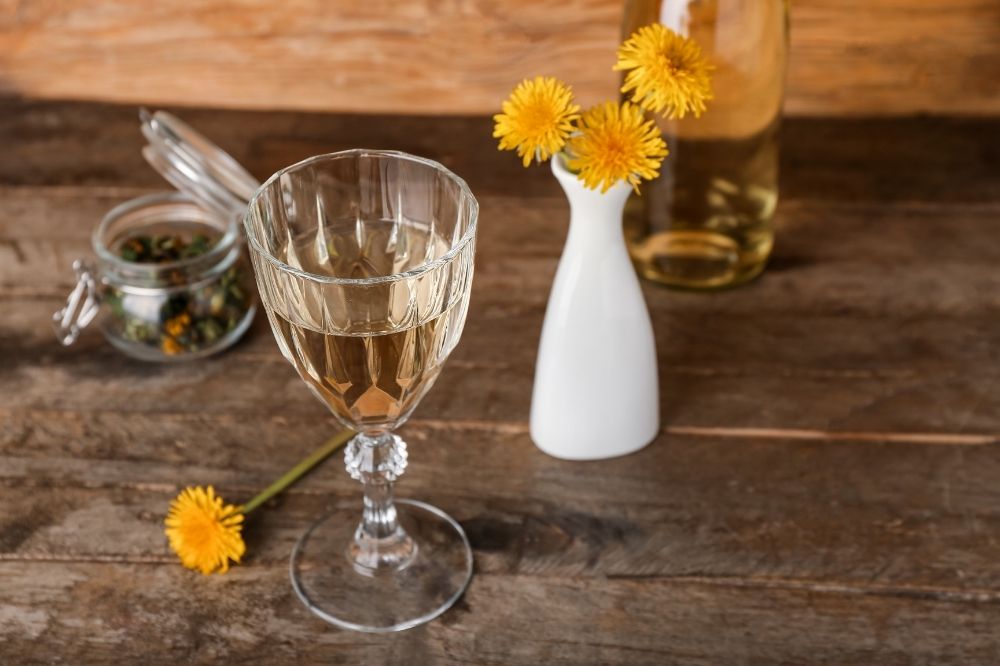What if you could capture spring’s golden essence in a bottle? Learning how to make dandelion wine transforms ordinary yard “weeds” into liquid sunshine that rivals any premium vintage. This ancient craft has captivated artisans for centuries, and now you can master it too. Dandelion wine popularity has surged significantly in the last few years, and as a result, many home brewers have been exploring country wines from foraged ingredients of late. This renaissance reflects growing interest in sustainable, artisanal beverages that connect us to traditional methods.
The Dandelion Wine Making Process
Before we discuss how to make dandelion wine, it’s important to remember that the transformation from dandelion petals to finished wine spans 3-6 months through distinct phases. You’ll begin with careful foraging and flower preparation, creating a floral infusion that becomes your wine’s foundation. The primary fermentation runs for 10-14 days, followed by the secondary fermentation and aging that help the wine develop complex flavors. Dandelion wine typically achieves 10-14% ABV, comparable to commercial wines. The finished product has a light golden color with delicate floral notes and subtle honey-like sweetness. Properly crafted dandelion wine exhibits remarkable complexity, often surprising traditional wine enthusiasts.
Core Equipment Requirements
The primary fermentation process demands a food-grade plastic bucket or glass carboy (minimum 2-gallon capacity). Essential accessories include fermentation locks, rubber stoppers, fine-mesh strainers, and a hydrometer for monitoring progress. The secondary fermentation requires clean glass carboys, additional fermentation locks, and sanitizing solutions. Traditional fermentation vessels help optimize flavor development while maintaining sterile conditions.
Ingredient Selection and Quality
Fresh dandelion flowers form the wine’s foundation. Harvest a gallon of loosely packed flowers, focusing on bright yellow petals while avoiding green parts that introduce bitterness. Choose pesticide-free locations, preferably during early morning hours when flowers are fully opened. The sugar and yeast selection dramatically impacts the final flavor. Most recipes require 2.5-3 pounds of granulated sugar per gallon of must (freshly crushed fruit juice). Wine yeast strains like EC-1118 provide reliable fermentation, though wild yeast offers traditional unpredictability.
Step-by-Step Dandelion Wine Recipe
There are three major steps or processes involved in the production of dandelion wine:
Flower Preparation and Initial Processing
Begin by carefully removing the petals from the stems, as the green parts create unwanted bitterness. Rinse the petals gently in cool water, removing debris or insects, and place the clean petals in your primary fermenter. Boil four quarts of water and pour it over the dandelion petals. Cover with a lid and steep for 24-48 hours, stirring occasionally. This creates the floral base that gives dandelion wine its distinctive character.
Creating the Must
Strain the dandelion tea through a piece of cheesecloth, pressing the petals to extract the maximum flavor. Discard the spent petals and return the liquid to the fermenter. Add dissolved sugar, stirring until completely incorporated.
You can also enhance the fermentation with certain citrus additions:
- Juice and zest from 2 oranges
- Juice and zest from 1 lemon
- Optional: 1/2 cup golden raisins for complexity
Primary Fermentation Process
Cool the must to 70-75°F before adding yeast. Sprinkle wine yeast over the surface, allowing 10-15 minutes for hydration before stirring gently. The primary fermentation begins within 24 hours, indicated by bubbling activity. Monitor daily, stirring gently to prevent surface mold. Primary fermentation completes in 7-10 days when the vigorous bubbling subsides. The specific gravity should drop from 1.090 to 1.020 or lower.
Advanced Techniques and Troubleshooting
Wine production can be quite complicated, with the following being some of the most commonly encountered aspects:
Achieving an Optimal Flavor Balance
Managing bitterness requires careful technique throughout the process. Use only bright yellow petals, avoiding white petal bases and green parts. If bitterness develops, cold conditioning for 2-4 weeks can improve the flavor balance. Fermentation specialists recommend maintaining 65-75°F during primary fermentation. If fermentation stalls, you can also consider adding yeast nutrients. Some makers add honey for complexity, creating dandelion mead hybrids.
Common Problems and Solutions
Inadequate settling or protein haze often leads to cloudy wine. Use bentonite clay or egg whites as fining agents, followed by careful racking. Fermentation failures typically stem from temperature issues or insufficient nutrients. Off-flavors can also develop from contamination or stressed yeast. Maintain proper sanitation throughout the process. If wine develops vinegar notes, it may be salvageable through sulfite treatment and blending.
Secondary Fermentation and Aging
Once the primary fermentation is complete, you should transfer the wine to a secondary fermenter using a siphon, leaving the sediment behind. This first racking occurs after 2-3 weeks when the fermentation activity significantly slows down. Attach an airlock and store in cool, dark conditions. Subsequent rackings every 2-3 months can help clarify the wine and prevent off-flavors from developing. Each racking process should show progressively clearer wine with less sediment formation. Basic drinkability requires a minimum of 6 months for aging, though most dandelion wines benefit from 12-18 months of maturation. It’s best to store the bottles on their sides in temperature-controlled environments.
Safety and Legal Considerations
Identify dandelions correctly to avoid picking toxic look-alikes. True dandelions have deeply toothed leaves and hollow stems with white milky sap. Avoid areas near roads, treated lawns, or industrial sites where contamination is likely. Home wine production falls under federal regulations, allowing up to 200 gallons annually for personal consumption. Alcohol content monitoring can help ensure safe consumption levels.
Serving and Pairing Suggestions
Serve dandelion wine slightly chilled at 50-55°F to highlight its delicate floral character. The wine pairs beautifully with light appetizers, soft cheeses, and spring vegetables. Consider serving it alongside artisanal meads for a complete tasting experience. Complementary flavors include honey-based desserts, goat cheese, and herb-crusted fish. The wine’s subtle sweetness balances spicy foods, while floral notes enhance spring salads and vegetable dishes. Mastering the art of making dandelion wine helps connect you with centuries of traditional craftsmanship while creating a unique beverage that captures spring’s essence. The process requires patience and attention to detail, but rewards dedicated makers with a truly distinctive wine.

